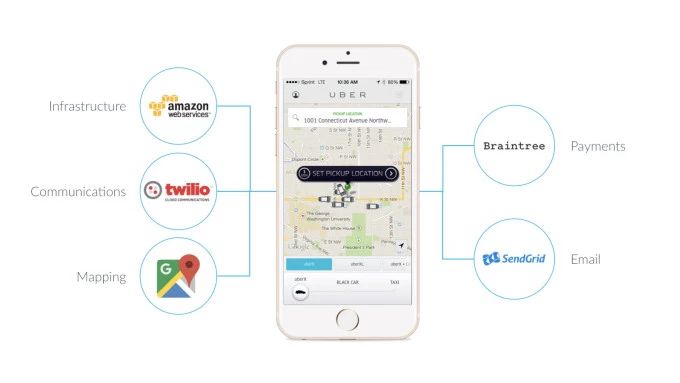How Uber Takes Advantage of the API Economy
You’ve probably heard about APIs and the API economy, and how they’re changing the way that applications are built. Companies like Uber and Airbnb that utilise 3rd party APIs extensively throughout their products have achieved a world class customer experience while being able to scale considerably fast.
Focus on your strengths
At the practical level, when you examine the technology components of Uber, they rely on other core services to build their mobile app. By leaving it to specialists who focus on niche elements like payments and infrastructure, Uber can focus on their core competency of delivering transportation as a service.

To achieve this logistical feat, Uber relies on service specialists to power many of the key elements of their mobile application. For example, Uber uses Amazon Web Services (AWS) for their infrastructure to be able to continuously operate without disruptions. For their mapping technology, Uber utilises Google Maps to help riders and drivers find each other. Their messaging stack is provided by Twilio, ensuring you get that notification right when your driver arrives. With SendGrid APIs, Uber can send out emails and receipts for passengers with an email service.
Uber leaves all these functional elements to the service specialists who focus on these areas as their core business, while Uber itself focuses on their core competency of delivering transportation to the masses.
This laser focus allows them to put all their energy on their primary objective: providing world-class transportation.
The benefit of this approach is not only in getting the initial application built, but freeing resources from the ongoing maintenance of these non-core elements of the stack. Making the commitment to build highly scalable apps like Uber is a massive undertaking without 3rd party API providers. Not only do you need to think about infrastructure and communications, but also user management—especially in customer application scenarios.
Identity as a service
Every application needs a way to connect directly to the user. Thus, almost every app has an authentication component. A customer identity and access management (CIAM) solution is another such specialist service that provides a common set of fundamental features related to authentication, authorisation, and user management. Implementing an identity service provides application development teams with:
- The ability to increase speed-to-market
- Lower development costs
- The freedom to focus in-house developers on the core features of the application while offloading the complexities of modern identity and access management.
What to look for in an identity service
A modern CIAM solution provides a digital identity layer that can be embedded into your customer-facing apps and portals. There are four main capability pillars that a modern CIAM solution needs to deliver on when it comes to addressing customer needs:
- Frictionless user experiences
- Speed-to-market
- Centralisation of access management
- Internet scale security
Modern CIAM with Okta Identity Cloud
Purpose-built for the modern era, the Okta Identity Cloud offers a completely new category of technology that enables organisations to deliver secure, consistent digital experiences for their workforces, partners, suppliers and customers.
Okta’s simple-to-use APIs and out-of-the-box tools enable developers to create seamless experiences, while giving IT and security teams a centralised place to manage security policies. Okta’s API Products serve as identity building blocks for your mobile or web applications, providing several core services to accelerate the time-to-market of your digital transformation:
- Embeddable Authentication
- Embeddable Authorization
- User and Policy Management
To learn more about the Authentication API that Okta offers, visit our Authentication API @ Okta page or check out how you can Add Authentication to Any Web Page in 10 Minutes.

